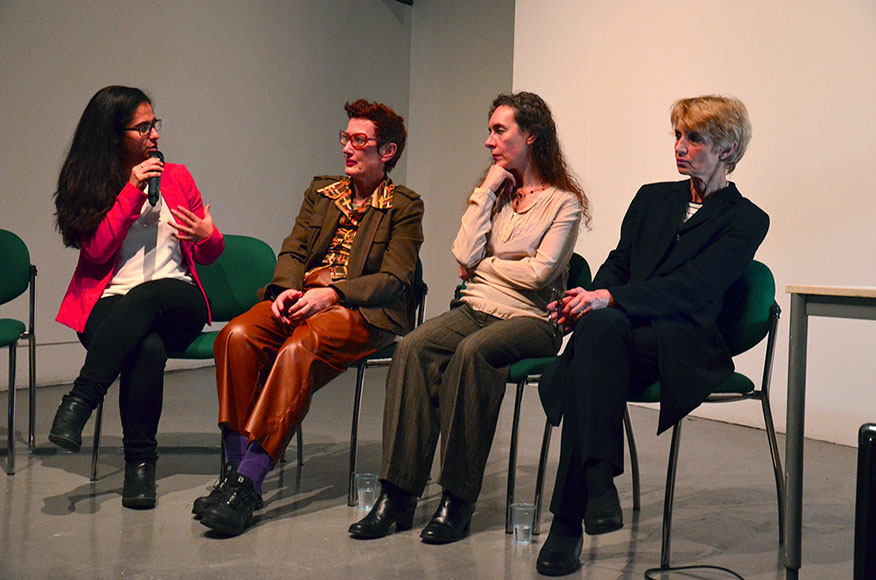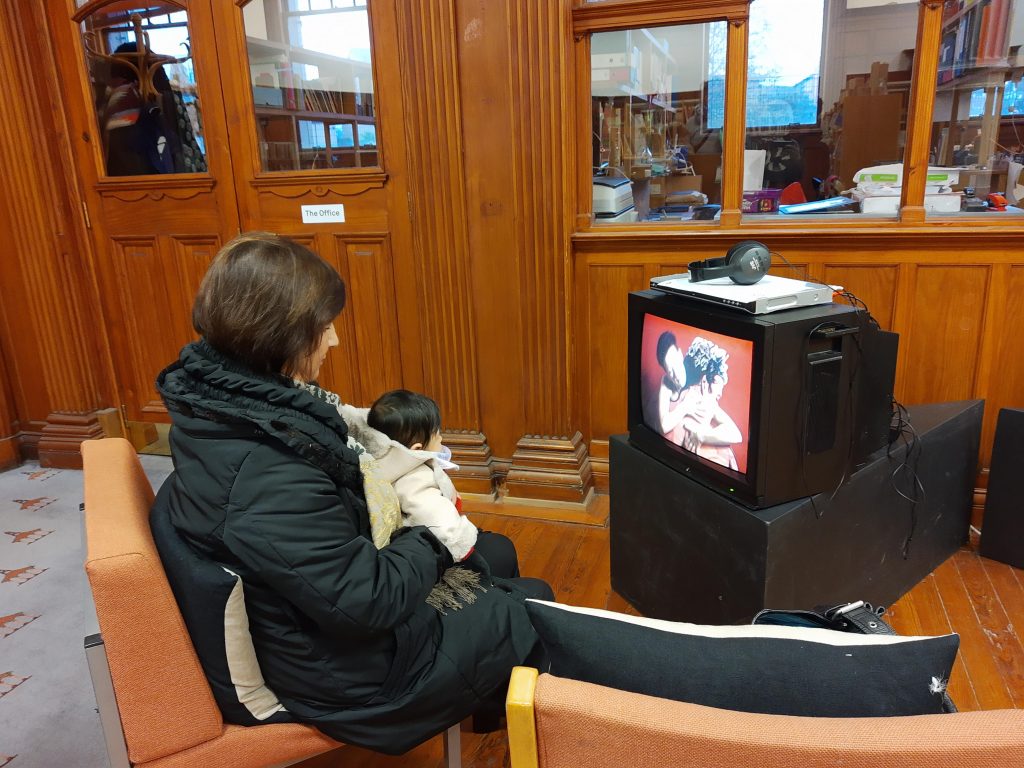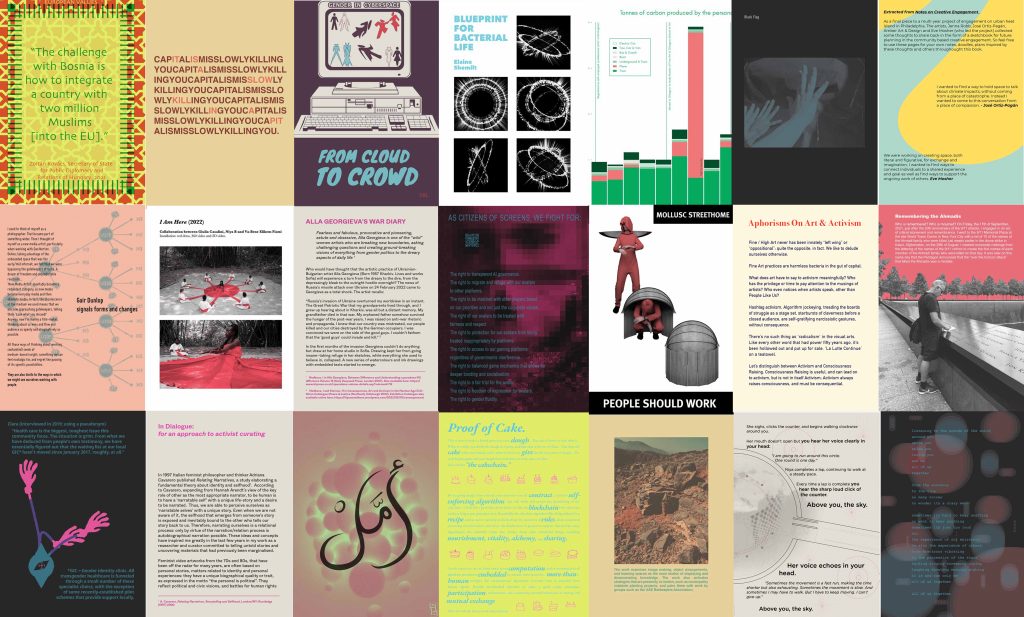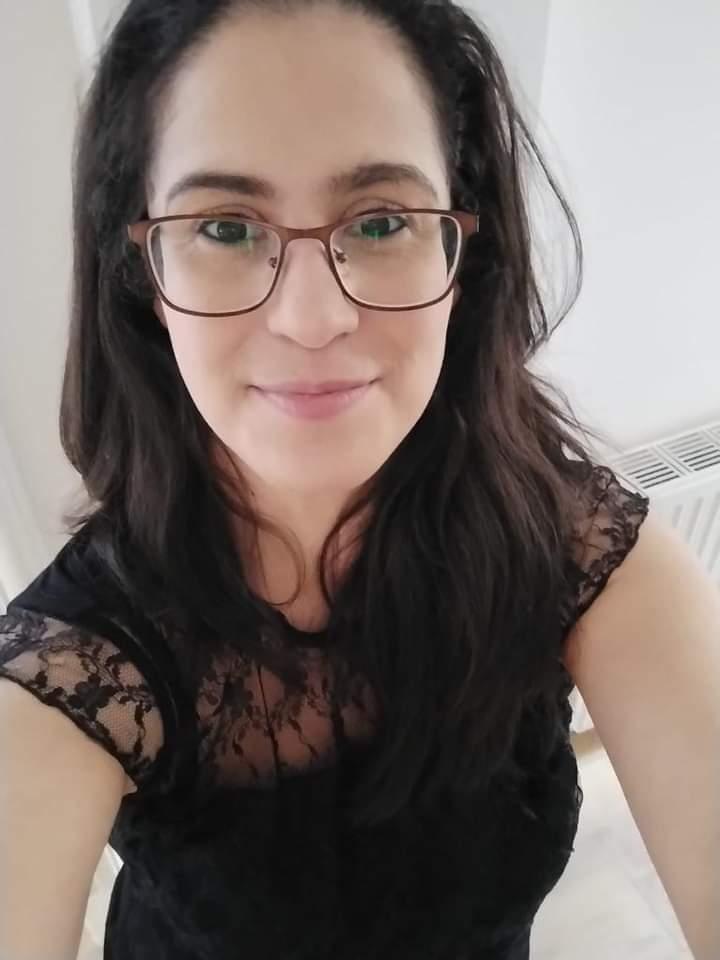LAURA LEUZZI
Generazione Critica: Your career as a researcher began at La Sapienza University in Rome, with a PhD in Tools and Methods for Art History. Your dissertation, titled “The List, Classification and Catalogue as Art Practices in the Twentieth Century”, set the starting point. Later, you started working at the University of Dundee, Scotland, on the “REWINDItalia – Artist’s Video in Italy in the 70s and 80s” project, funded by the Arts and Humanities Research Council, under the direction of British video art pioneer Stephen Partridge. During your time there, you have been involved in various projects covering topics such as the role of women artists in video art between the 1970s and 1980s, and activist practices in relation to digital art. Could you tell us how your research activity has developed over the years and what changes occurred while working both at La Sapienza and the University of Dundee and then at RGU?
Laura Leuzzi: I started working at the University of Dundee in 2011. I had just finished my Ph.D. and I had the opportunity to work on REWINDitalia, a research project that aims at putting the exceptional contribution of Italian artists, theorists, curators, and production centers to the development of video as an artistic practice back in the international spotlight. REWINDitalia gave me the wonderful opportunity to work in a team with archivist Adam Lockhart, delving into issues of preservation and reinstallation, interviewing several leading figures of the time, and studying in-depth video experimentations and more generally several art practices of the 1970s and 1980s. Within this context, I had the chance to take my first steps internationally as a curator and researcher. For example, bringing a selection of Italian videos to VideoEx (Walcheturm, Zurich) in 2014, or participating in the editions of Media Art Histories Conferences Since 2013 in Riga.
Later with Steve and British video artist Elaine Shemit, we developed a project on women’s video art in Europe in the 1970s and 1980s, EWVA, realizing how women artists’ contributions to video art were still too often marginalized and that there were common elements to the video art practices of contemporary women artists due to the emergence of themes connected to the second wave feminism. This element led me to focus on themes such as the portrait, self-portrait and representation related to the body and the medium.
REWINDitalia and EWVA resulted in two books that I co-edited, which were followed by Richard Demarco: The Italian Connection, about the Scottish-Italian gallerist’s relationship with Italy.
At the same time, I started the Digital Art and Activism network with American artist Joseph DeLappe, funded by the Royal Society of Edinburgh, which focuses on digital art and activism, research I later pursued at La Sapienza, along with an investigation on performance and reenactment. The network is still active and we hope to develop it with other projects in the future.
Since August, I have been Chancellor’s Fellow at Gray’s School of Art, part of Robert Gordon University in Aberdeen, where I am developing a program on digital art and activism, with several projects focusing on specific themes and with different approaches.

Self/Portraits co-curated by Laura Leuzzi, Giulia Casalini and Diana Georgiou (from left: Laura Leuzzi, Lydia Schouten, Cinzia Cremona, Elaine Shemilt), DCA, Dundee, 2016. Source: ewva.ac.uk
GC: In addition to your work as a researcher, you are also involved as a curator. During the Prospectives 2023 workshop, which examines the relationship between the arts and activism from a multidisciplinary perspective – and organized as part of the International Summer School of the Scottish Graduate School for Art and Humanities – you discussed how research and curating are intertwined in your work. You described the use of reenactment as a tool for investigating performance and video artworks of the 1970s and 1980s, from theoretical, art historical and curatorial perspectives. Your talk focused on case studies from the REWIND, REWINDItalia and EWVA (European Women’s Video Art in the 70s and 80s) research projects. How did you start using reenactment as a practice-based research tool and how has it influenced your work as a curator?
LL: My first approach to reenactment actually took place many years ago. A friend and colleague of mine, Emanuele Sbardella, curated a performance by Cesare Pietroiusti at MLAC, Sapienza, which I attended as an audience member, and at the end of the performance, Cesare had asked to repeat the action the following year. From there, Sbardella and I curated two cycles of reenactment that led to a volume – to which Cesare himself and Domenico Quaranta contributed – which focused on performance, new media and digital and the several forms that reenactment may assume.
A few years later, invited to the VideoEx Festival at the Walcheturm in Zurich with Partridge, as part of a screening dedicated to REWINDItalia, we invited Italian musician Claudio Ambrosini to reenact live one of his video performances entitled Videosonata, produced by the Cavallino in Venice in 1979. And it was there that I realized the potential of reenactment as a tool: being able to study up close how the artist made the work. Specifically, with one hand Claudio replicated on the keyboard the rasterization of the screen while with the other hand, he pinpointed elements on the projected image. So, when I was invited by the Visions in the Nunnery Festival at Bowarts in London in 2016, I proposed to Elaine Shemilt to do a reenactment of one of her video performances, Doppelganger. In rehearsals, she finally remembered and told me about the function of the feedback monitor to make her self-portrait on the mirror that is seen in the video. Thus, we learnt more about how the video took advantage of one of the great and innovative technical features of portable video: the feedback.
In addition, the close-up image projected on the wall at the Festival stimulated an empathetic engagement of the audience and allowed for a closer appreciation of Shemilt’s work.
So reenactment for me became a practice-based research method.
GC: What are the main differences between this methodology and the traditional curatorial practice?
LL: Research is always at the center of my curatorial practice, and the experimentation with new formats and platforms is a fundamental part of the process of research and dissemination of its results, involving and exchanging with both expert and general audiences. This exchange not only informs the evolution of these platforms, as they change, evolve, and adapt to different settings or subject matter, but also informs the research itself, nurturing different approaches and points of view. This is why I tend to never repeat the same formats, which by their nature are experimental and bound to a specific moment of the research process.
This is why I find digital art festivals particularly interesting, because they allow for a certain degree of experimentation and for testing novelty.
Secondly, I also try to reflect theoretically on the elements and approaches adopted, and then conferences and subsequent conference proceedings become privileged places of reflection and discussion with colleagues.
Prospectives 2023, co-organized with DeLappe as part of the International Summer School of the Scottish Graduate School for Art Humanities, allowed us precisely to examine practice-based research on the topic of activism from a multidisciplinary perspective. With DeLappe, who in turn spoke about his many projects on pacifism on digital and in-game platforms, we engaged theorists such as Martin Zeilinger (University of Abertay, Dundee) who is working on AI and blockchain; Maja Zeco (RGU) whose sound art projects explore the density of time and different spaces (her works based in part on her experiences in the Sarajevo siege during 1992-95 are very intense) and how they are interacted with by involving several audiences (Silencer); Emile Shemilt (Napier University) who discussed his photographic research in the South Georgia archives that testify to the environmental drama we are experiencing with climate change and the whaling industry; composer Dimitri Scarlato (Royal College of Music, London) who in operas and symphonies has explored topical issues such as gender-based violence (e.g., his work Fadwa deals with feminicide, and although inspired by news events of more than 10 years ago, it is still dramatically relevant with the recent tragedy of the feminicide of Giulia Cecchettin), mental health (A Life Reset) and Brexit (In Limbo), Prof. Antonella Sbrilli (La Sapienza University of Rome) who spoke about her experience with artists with disabilities from the Sant’Egidio community; Jon Blackwood discussed his experience as art historian, researcher and curator in activist art in the Balkans.

EWVA Book Launch, Glasgow Women’s Library, November 2019 (on the screen Lydia Schouten, Romeo is bleeding, 1982). Courtesy of Laura Leuzzi.
GC: In your presentation, you described the role of the artist as someone as an ‘agent of change’ work has the potential to affect contemporary culture and society. Could you elaborate on this idea and explain how your work relates to this view of the artist? In your opinion, how is it possible to assess the impact of artistic activities that employ activist practices, drawing also on your research experience at the React Digital art and Activism project and your work with artist and scholar Joseph DeLappe?
LL: The role of the artist, in this extremely complex historical moment, can be instrumental in prompting reflection on major contemporary issues ranging from the great challenges on environment, rights, equality, pacifism, immigration. Gender violence and new technologies that pose so many challenges of ethics, morality, economics, environment, access etc. such as AI, blockchain, cryptocurrency and still elements of our daily reality such as social media, virtual worlds and video games.
In this multifaceted and complex world, new media pioneers and artists working on new technologies today are at the forefront of understanding, rethinking and hacking tools made often for purely commercial purposes that nonetheless can be vehicles for change, not only in an activist use but also to bring different issues and points of view to the attention of the general public. The artist’s intervention then goes from the macro to the micro with the involvement of small communities.
GC: In September, the RE_EXHIBIT online exhibition program was launched, which you curated with Adam Lockhart as part of the REWIND Artists’ Video project, which opened in 2004 by Professor Stephen Partridge. How did RE_EXHIBIT come about and how does it fit into the broad landscape of projects carried out within REWIND?
LL: Adam Lockhart and I recently started this new curatorial platform with the challenge of experimenting with new curatorial formats to promote the Rewind Collection and then video art in general from its origins, with the goal of exploring different contemporary approaches and discourses.
The project is all about accessibility because it allows the works to be enjoyed directly from home with the goal of reaching diverse audiences.
We opened with an exhibition on two-person collaborations curated by academic and artist Chris Meigh-Andrews, which was followed by our first video commission. A performance by Italian artist Cinzia Cremona stands as a response to Tamara Krikorian’s Vanitas, which explores through the gaze and interaction between performer and camera the theme of narcissism already raised in relation to Rosalind Krauss’s video.
This will be followed by a group show curated by Jon Blackwood, focusing on the first decade of Macedonian video art, still little known to artists and art historians outside of North Macedonia.
GC: In November you will release INCITE: Digital Art & Activism, a collaborative artist’s book that you co-edited with Joseph DeLappe that brings together contributions from numerous artists, scholars and activists whose work revolves around activist practices in relation to art and digital spaces. The volume was produced by Peacock and presented on November 10 at The Worm gallery in Aberdeen, Scotland. Can you tell us about the genesis of this collaboration between you curators and with the authors involved in the project?
LL: This volume stems from the experience at the Digital Art and Activism Network. After a workshop at the V&A Design in Dundee, Peacock’s director Nuno Sacramento suggested that we create an artist’s volume to leave a record of the discussions and exchanges that followed. This started a collaboration with Peacock’s Neil Corall and Enxhi Mandija, which led us to the realization of this artist’s volume in risograph printing with 21 original contributions from artists, curators, theorists, designers, and activists who recount their experience and the issues they are dealing with.
For example, in my contribution, I reflected on the relationship of intimacy and dialogue I weave with women artists and how I use it to bring out stories and practices of women artists who confront feminist struggle by exploring themes of the body, identity and representation.
What emerges are the connections and the transferability of certain approaches to art activism that have the ambition to stimulate new research and practice.
There are many particularly interesting interventions but I would like to point out, among the many, that of Giulia Casalini in collaboration with the Ghanaian artist Va Bene brought to our attention through a ritual, a performance the regenerative potential of art in the current dramatic situation of the rights of the LGBTQAI+ community in Ghana; Niya B who highlighted the difficulty of access to hormonal treatments needed by the trans community; or Martin Zielinger who with a ‘recipe’ problematizes aspects of blockchain, and Ellie Harrison’s talked about her famous project The Glasgow Effect, curator Iliyana Nedkova’s talk on Ukrainian artist Alla Georgieva’s war diary; Joseph DeLappe devoting a talk to the theme of memorializing victims in the case of the Ahmadi family; BD Owens with an anti-capitalist verbovisual intervention; Donna Holford Lovell on the theme of gender in cyberspace; Elaine Shemilt on the collaboration between artists and scientists in research and Emile Shemilt with a photo series on the drama of the refugee crisis in the Mediterranean. And again, Eve Mosher on the topic of art project engagement in communities; Gair Dunlop reflecting on art, new media, and activism; Hadi Mehrpouya & Duncan Nicoll trying to define a Social Gaming Manifesto; John Butler problematizing exploitation in today’s society’s work; Jon Blackwood who with his aphorisms joins the tradition of the artist/activist manifesto; Maja Zećo who denounces Islamophobia and prejudice against the countries of the former Yugoslavia by Europe; Moza Almatrooshi who, with a cultural-historical perspective, recounts beekeeping in the postcolonial realities of the United Arab Emirates; Tom de Majo’s talk on sensation experience and activism; Malath Abbas with a pacifist intervention; and Zoyander Street who closes the volume with a reflection on access to healthcare by the LGBTQAI+ community.

J. DeLappe, Laura Leuzzi, ed., Incite, Peacock and the worm, Aberdeen 2023.
Incite, covers, Peacock and the worm, Aberdeen 2023, photocomposit and covers.
GC: Would you tell us about the new Fellowship at RGU?
LL: I am one of the new Chancellor’s Fellows who represent a large investment by Robert Gordon University to develop interdisciplinary research projects in the university.
I am based at Gray’s School of Art, where I am developing research and curatorial projects with my new colleagues. In spring 2022 RGU launched a new research strategy identifying four interdisciplinary research themes to focus on: Environment, Energy and Sustainability; Living in a Digital World; Health and Wellbeing; and Inclusive and Creative Societies. If you are interested in learning more about it, there is a video in which Prof. Nick Fyfe, RGU Vice-Principal for Research and Community Engagement, Grant Davidson, Head of Research Strategy, Culture & Performance, and researchers across the whole University talk about interdisciplinary, innovative and collaborative research at RGU: video link.
For my fellowship, I proposed an umbrella project on digital art and activism – which, centered on Living in a Digital World, tangentially touches on the other themes – that can develop in an interdisciplinary way collaborative research with artists, practitioners, curators, and experts from various disciplines on the grand challenges of our contemporary world through new technologies. The project aims to develop broad engagement with diverse audiences and have an impact on academia and society more broadly, helping to develop, communicate and expand the importance of the role of the artist and art in our society. Always keeping at the center an intersectional feminist perspective that has inclusivity and accessibility as its core values. The great pioneers of new media have always brought a strong reflection on major social, political, ecological and historical issues in a complex interdisciplinary dialogue: it is important to critically recover this history, to investigate and experiment in the contemporary both theoretically and in a practice-based method, in order to look to the future.
The other fellows are Gael Morrow (School of Pharmacy and Life Sciences), Joanna Shim (School of Health Sciences), William Ball (School of Nursing, Midwifery and Paramedic Practice), Anne-Marie Foster (School of Creative and Cultural Business), Ruby Roberts (Aberdeen Business School), Ikechukwu Nkisi-Orji (School of Computing), Wei Zhang (National Subsea Centre) and Vinoth Ramalingam (School of Engineering). I truly look forward to exchanging ideas and possibly initiating projects with them.

